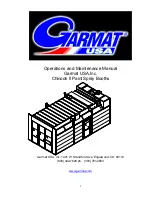
9
Aadva Lab Scanner 2
Manual
PROTECTION AGAINST MATERIAL DAMAGES
Despite the protective measures included in the design, some residual risks that might lead to material damages (loss of
data or damage to devices) cannot be excluded. In this section you will learn what measures can be taken against material
damages.
Optics/Electronics
NOTE
Damage to optical and electronic components due to touching, humidity, dirt and cleaning
The optical and electronic components in the interior of the scanner are highly sensitive. Any touch, as well as dirt,
moisture and cleaning agents can damage them.
•
Do not touch any optical and electronic components,
•
Protect the optical and electronic components against soiling by covering the scanner.
•
Never use the 3D scan spray inside the scanner.
•
If the optical or electronic components have to be cleaned, do not do it yourself. Please contact GC.
Carrying
NOTE
Damage to the scanner due to incorrect carrying
The front upper corners are not suitable to be used as carrying handles. If you carry the scanner by the front upper
corners, they can come off and the scanner will fall and get damaged. If you reach into the front upper corners,
you can damage sensitive components, especially the camera and the sensor.
•
To transport the scanner, always grasp it by the bottom corners, never by the front upper corners.
Cleaning agents
NOTE
Damage to surfaces due to unsuitable cleaning agents
Paper towels, coarse cotton cloth, detergents, polishing paste, etc. leave scratches on the sensitive surfaces.
•
Only use the recommended materials for cleaning.
Moisture
NOTE
Material damages due to moisture
Constant contact with moisture can damage sensitive materials.
•
Only operate the scanner at a dry workplace.
•
Avoid any contact with water/moisture. Should this however happen at some time, disconnect the power plug
immediately. Immediately wipe off any water/moisture using a soft microfiber cloth.
Climate
NOTE
Measuring errors due to unsuitable climatic conditions
The scanner is designed solely for use inside dry, closed rooms. Precise measurement results are only achieved
by the scanner under suitable climatic conditions. Too much heat causes measurement errors and overheating of
the scanner. Overheating can permanently damage the scanner.
•
Only operate the scanner at temperatures of 18°C – 30°C.
•
Only operate the scanner in low humidity conditions.
•
Avoid direct sun exposure at the workplace.
•
Reduce cold, heat and high humidity, e.g. through the use of air conditioners or sun protection.
Summary of Contents for Aadva Lab Scanner 2
Page 55: ...55 Aadva Lab Scanner 2 Manual ...










































